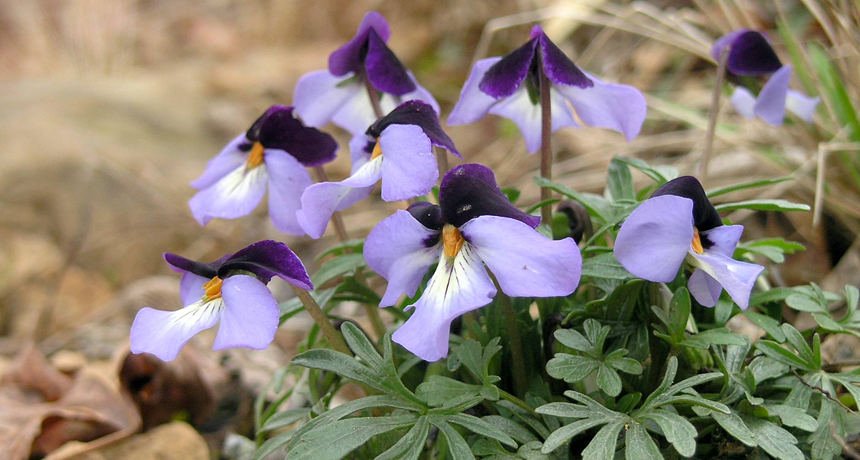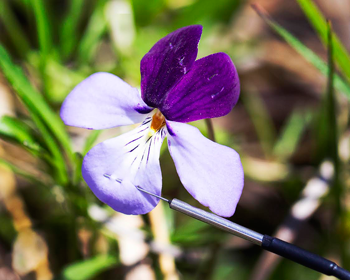Warm petals may attract chilly bees
Violets with dark petals may give bees a warm spot to rest their bums

The birdfoot violet is a common spring wildflower in parts of North America. Scientists want to know why it comes in two morphs, or color types. This is the two-toned form.
Marvin Smith / Flickr (CC BY-SA 2.0)
Share this:
- Share via email (Opens in new window) Email
- Click to share on Facebook (Opens in new window) Facebook
- Click to share on X (Opens in new window) X
- Click to share on Pinterest (Opens in new window) Pinterest
- Click to share on Reddit (Opens in new window) Reddit
- Share to Google Classroom (Opens in new window) Google Classroom
- Click to print (Opens in new window) Print
The birdfoot violet blooms in fields and forests in the central and eastern United States and Canada. Why this wildflower comes in two differently colored varieties has long been a mystery. But a new study may have an answer. Its field data suggest that blooms with two-toned petals may attract bees by providing a warm spot to rest their chilly bums.
Among these flowers, the most common form — or morph — has five light-purple petals arranged in a ring. But some of these violets instead have three of the pale-purple petals and two dark-purple ones. Researchers have now probed what advantages one form may have over the other.
Dark objects — especially black objects — tend to heat up in the sun more than light objects do. (Think of a hot blacktop driveway on a summer day. Ouch!) After all, black absorbs all wavelengths of light. And energy from that absorbed light collects as heat. Light objects often feel cooler, because lighter colors absorb some wavelengths of light but reflect most others.
The dark petals of the birdfoot violet aren’t black. But their purple is so dark that it looks almost black. This effect is called “optic black,” explains Peter Bernhardt. He studies plants at Saint Louis University in Missouri. (The word optic refers to how an animal sees an object.)

Scientists had guessed for many years that this optic blackness made the dark-purple petals warmer than the lighter ones. If so, then those warmer petals might make an attractive perch for bugs seeking the pollen and sweet nectar from inside the flowers. “It’s like putting on a black coat when it’s cold outside and sitting in the sun,” explains Bernhardt. Yet no one had actually measured the temperature difference between the two types of petals.
So Bernhardt, his colleague Retha Edens-Meier and others set out to do just that. They took the temperatures of violets in a sunny open field and in a shaded forest. Both sites were in Missouri. Edens-Meier poked a thermometer as thin as a needle through both light and dark petals. On average, dark-purple petals were about 3 degrees Celsius (5.4 degrees Fahrenheit) warmer than light-purple ones.
“For a cold-blooded insect” landing on a flower, “that’s a big difference,” Bernhardt notes.
Snug for a bug?
Scientists knew that some flowers use warmth to attract bees and other pollinators. (Pollinators are insects and other animals that help flowers reproduce.) The Arctic poppy uses its cup-shaped petals to direct rays of sunlight to its center. This creates a warm spot for landing insects. And that warmth is welcome in the cold polar regions where that poppy grows.
The birdfoot violet blooms in early spring. That can be quite a chilly time across its range. Bernhardt, Edens-Meier and their team wondered whether bees preferred the violet morphs with warmer, dark-purple petals. Since bees pollinate these flowering plants, a preference for one form of the flower could have major impacts on its population size.
For two springs, the biologists tracked bee activity at their two study sites. Bees in the sunny field rarely visited the violets with dark petals. Little surprise, the light-colored violets that they preferred were far more common there than were violets with dark petals. In fact, there were 40 times more light-colored violets at the sunny site than ones with two-toned blooms!
That same overwhelming preference for pale-flowered blooms did not show up at the shaded forest site. Bees there actually preferred the two-toned blooms. And this seems to have affected how many of those plants populated the area. The researchers counted 59 light-colored violets and almost as many — 51 — of the flowers with two-toned blooms.
The team published its findings in November in the Journal of Pollination Ecology.
What to make of the findings
Some bees at the forested site also hung upside-down from the dark-purple petals as they visited to collect pollen. The position is awkward. Normally, bees won’t hang upside down to suck nectar. The insects could be doing this to warm their backsides on the dark petals, the researchers now suspect. Petal warmth may be more important to bees supping in a cool, shady forest than to those bees dining in warm, sunny fields, Edens-Meier now suspects.
Story continues below video
The birdfoot violet isn’t the only flower that comes in different color morphs.
Many wildflowers have two or more color morphs, notes Randy Mitchell. A biologist, he works at the University of Akron in Ohio and wasn’t involved in the new study. Mitchell studies how plants and their pollinators interact. And figuring out why different flower morphs exist is a fundamental biology question, he notes. Botanists also want to know what role pollinators may have in determining which color morphs are more common.
“Knowing that there is a temperature difference between light and dark petals is a good start,” says Mitchell. But the new study leaves a lot of questions unanswered, he adds. How much are bees actually warmed by dark petals, for example? Researchers could take the bees’ temperatures to find out, he suggests. Future studies also could look at what other things might affect how common different color morphs are. For instance, he asks, do some animals prefer eating one flower type over the other?
“It’s really exciting that something as simple as the color of a flower can give us insights on important issues like why there’s variation in the biological world,” Mitchell says.







